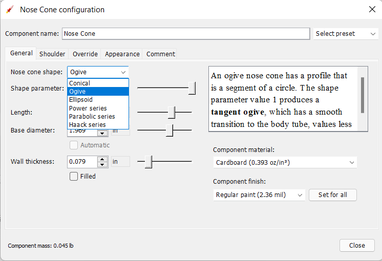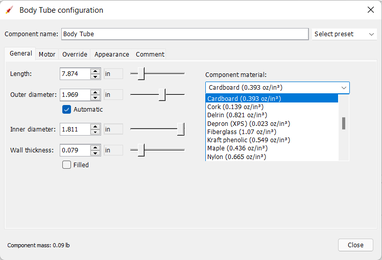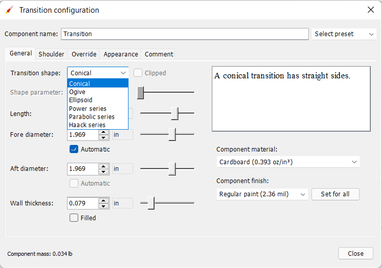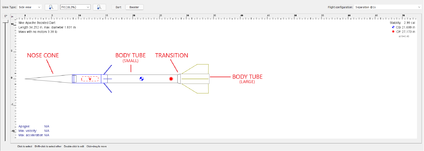Difference between revisions of "Body Components Basics"
Hcraigmiller (talk | contribs) m |
Hcraigmiller (talk | contribs) m |
||
| (20 intermediate revisions by the same user not shown) | |||
| Line 1: | Line 1: | ||
<div style="text-align: center;"> | <div style="text-align: center;"> | ||
| − | <div style="float: left;">[[FAQ|Go to Frequently Asked Questions | + | <div style="float: left;"> ← [[FAQ|Go to Frequently Asked Questions]]</div> |
<div style="float: right;">[[Tips|Go to Tips and Tricks →]]</div> | <div style="float: right;">[[Tips|Go to Tips and Tricks →]]</div> | ||
| − | [[Main Page|↑ Back to | + | [[Main Page|↑ Back to Main Page]] |
</div> | </div> | ||
---- | ---- | ||
| − | <table class="left | + | == Body Components Types == |
| + | |||
| + | <br> | ||
| + | |||
| + | <table class="left"> | ||
<tr> | <tr> | ||
<th>Component</th> | <th>Component</th> | ||
| Line 14: | Line 18: | ||
<tr> | <tr> | ||
<td>'''[[File:Components.02.01.Body-Fin.Nose_Cone.png|left|frameless|100 px|center]]'''</td> | <td>'''[[File:Components.02.01.Body-Fin.Nose_Cone.png|left|frameless|100 px|center]]'''</td> | ||
| − | <td><p>A nose cone is the conically shaped forward most section of a rocket, designed to modulate oncoming airflow behaviors and minimize aerodynamic drag. OpenRocket allows you to choose from seven different standard shapes, with the ability to significantly alter the shape of four of those. The shapes available to you are conical, ogive, ellipsoid, power, parabolic, and Haak (including the popular <i>Von Karmon</i> nose cone).</p></td> | + | <td><p><b>Nose Cones:</b> A nose cone is the conically shaped forward most section of a rocket, designed to modulate oncoming airflow behaviors and minimize aerodynamic drag. OpenRocket allows you to choose from seven different standard shapes, with the ability to significantly alter the shape of four of those. The shapes available to you are conical, ogive, ellipsoid, power, parabolic, and Haak (including the popular <i>Von Karmon</i> nose cone).</p></td> |
| + | </tr> | ||
| + | <tr> | ||
| + | <td></td> | ||
| + | <td>'''[[File:OR.Wiki.Body_Components.01.Nose_Cone.02.Dialog.Shape.png|left|frameless|382 px|center]]'''</td> | ||
| + | </tr> | ||
| + | </tr> | ||
| + | <tr> | ||
| + | <td></td> | ||
| + | <td><br></td> | ||
</tr> | </tr> | ||
<tr> | <tr> | ||
<td>'''[[File:Components.02.02.Body-Fin.Body_Tube.png|left|frameless|100 px|center]]'''</td> | <td>'''[[File:Components.02.02.Body-Fin.Body_Tube.png|left|frameless|100 px|center]]'''</td> | ||
| − | <td><p>The body tube, or tubes are the airframe of the model rocket. Body tubes are typically made from paper, fiberglass, or plastic, with the spiral-wound paper tube being the most common. OpenRocket allows you to set the length, inner and outer diameter (wall thickness), and material type. Whether designing low power or extreme high power rockets, OpenRocket allows you to set the body tube parameters you need.</p></td> | + | <td><p><b>Body Tubes:</b> The body tube, or tubes are the airframe of the model rocket. Body tubes are typically made from paper, fiberglass, or plastic, with the spiral-wound paper tube being the most common. OpenRocket allows you to set the length, inner and outer diameter (wall thickness), and material type. Whether designing low power or extreme high power rockets, OpenRocket allows you to set the body tube parameters you need.</p></td> |
| + | </tr> | ||
| + | <tr> | ||
| + | <td></td> | ||
| + | <td>'''[[File:OR.Wiki.Body_Components.02.Body_Tube.02.Dialog.Materials.png|left|frameless|382 px|center]]'''</td> | ||
| + | </tr> | ||
| + | <tr> | ||
| + | <td></td> | ||
| + | <td><br></td> | ||
</tr> | </tr> | ||
<tr> | <tr> | ||
<td>'''[[File:Components.02.03.Body-Fin.Transition.png|left|frameless|100 px|center]]'''</td> | <td>'''[[File:Components.02.03.Body-Fin.Transition.png|left|frameless|100 px|center]]'''</td> | ||
| − | <td><p>Transitions are used to connect two body tubes which have different diameters; the lack of a transition between dissimilar diameters is referred to as "discontinuity.” The same as with nose cones, transitions can have a curved surface such as ogive, ellipsoid, power, parabolic, and Haak, or just a traditional conical (flat sided) surface. Whether the difference in diameter is large or small, a transition is what is used to make that connection. Transitions can literally give your rocket that unique attention grabbing "shape.”</p></td> | + | <td><p><b>Transitions:</b> Transitions are used to connect two body tubes which have different diameters; the lack of a transition between dissimilar diameters is referred to as "discontinuity.” The same as with nose cones, transitions can have a curved surface such as ogive, ellipsoid, power, parabolic, and Haak, or just a traditional conical (flat sided) surface. Whether the difference in diameter is large or small, a transition is what is used to make that connection. Transitions can literally give your rocket that unique attention grabbing "shape.”</p></td> |
| + | </tr> | ||
| + | <tr> | ||
| + | <td></td> | ||
| + | <td>'''[[File:OR.Wiki.Body_Components.03.Transition.02.Dialog.Shape.png|left|frameless|382 px|center]]'''</td> | ||
</tr> | </tr> | ||
</table> | </table> | ||
| + | |||
| + | == Examples of Use == | ||
| + | |||
| + | <table class="left"> | ||
| + | <tr> | ||
| + | <th></th> | ||
| + | <th></th> | ||
| + | </tr> | ||
| + | <tr> | ||
| + | <td>Traditional →</td> | ||
| + | <td>'''[[File:OR.Wiki.Body_Components.04.Examples.01.Boosted_Dart.03.png|left|frameless|424 px|center]]'''</td> | ||
| + | </tr> | ||
| + | <tr> | ||
| + | <td>High Power Nose Cone →</td> | ||
| + | <td>'''[[File:OR.Wiki.Body_Components.04.Examples.03.HP_Nose_Cone.03.png|left|frameless|848 px|center]]'''</td> | ||
| + | </tr> | ||
| + | <tr> | ||
| + | <td>Comical Realism →</td> | ||
| + | <td>'''[[File:OR.Wiki.Body_Components.04.Examples.03.Anti-Virus.03.png|left|frameless|848 px|center]]'''</td> | ||
| + | </tr> | ||
| + | </table> | ||
| + | |||
| + | <p></p> | ||
| + | <br> | ||
---- | ---- | ||
<div style="text-align: center;"> | <div style="text-align: center;"> | ||
| − | <div style="float: left;">[[Go to | + | <div style="float: left;">← [[Assembly Components Basics|Go to Assembly Components Basics]]</div> |
| − | <div style="float: right;">[[Go to | + | <div style="float: right;">[[Fin Sets Basics|Go to Fin Sets Basics →]]</div> |
[[Component Details|↑ Back to Component Details]] | [[Component Details|↑ Back to Component Details]] | ||
</div> | </div> | ||
Latest revision as of 13:44, 25 February 2022
Body Components Types[edit]
| Component | Function |
|---|---|
Nose Cones: A nose cone is the conically shaped forward most section of a rocket, designed to modulate oncoming airflow behaviors and minimize aerodynamic drag. OpenRocket allows you to choose from seven different standard shapes, with the ability to significantly alter the shape of four of those. The shapes available to you are conical, ogive, ellipsoid, power, parabolic, and Haak (including the popular Von Karmon nose cone). |
|
Body Tubes: The body tube, or tubes are the airframe of the model rocket. Body tubes are typically made from paper, fiberglass, or plastic, with the spiral-wound paper tube being the most common. OpenRocket allows you to set the length, inner and outer diameter (wall thickness), and material type. Whether designing low power or extreme high power rockets, OpenRocket allows you to set the body tube parameters you need. |
|
Transitions: Transitions are used to connect two body tubes which have different diameters; the lack of a transition between dissimilar diameters is referred to as "discontinuity.” The same as with nose cones, transitions can have a curved surface such as ogive, ellipsoid, power, parabolic, and Haak, or just a traditional conical (flat sided) surface. Whether the difference in diameter is large or small, a transition is what is used to make that connection. Transitions can literally give your rocket that unique attention grabbing "shape.” |
|
Examples of Use[edit]
| Traditional → | |
| High Power Nose Cone → | |
| Comical Realism → |








